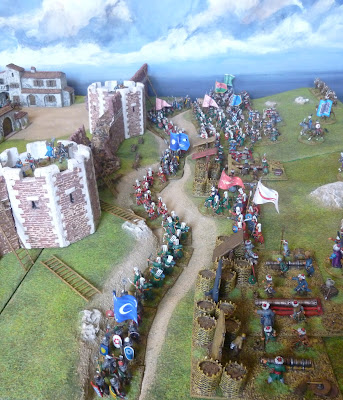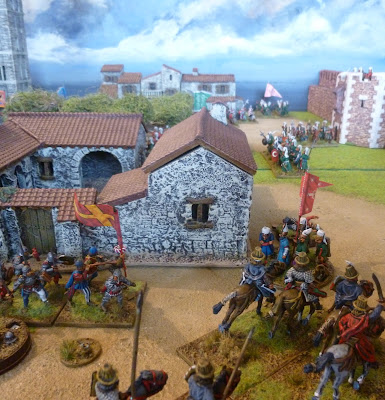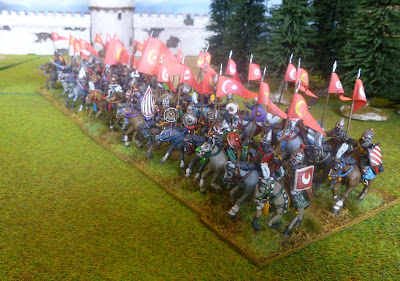
This weekend my friend Tom visited (check out his Hundred Years War blog here:
https://englandswarsinfrance.blogspot.com) and we continued our series of wargames. We played out a scenario based on the fall of the Venetian held Greek town of Modon, now called Methoni, to the Ottomans in August 1500. It meant we could give the harbour and boat their first outings as terrain pieces. I guess a Venetian galley would've been more suitable than a Carrack, but it looked the part none-the-less. This game also fitted in well with one of our previous table top clashes that centred around the Spanish aid that was sent to the Venetians under the leadership of El Gran Capitan, Gonzalo de Cordoba, following this siege,
http://camisado1500s.blogspot.com/2020/09/the-siege-of-castle-of-st-george.html.
The Siege of Modon, August 1500
The Ottoman-Venetian War of 1499-1503 started badly for the Republic's Greek Colonies. The 12 August 1499 saw the Venetians attempt to destroy the Ottoman fleet under Kemal Reis at Zonchio, but most of the Venetian galleys refused to engage resulting in a missed opportunity to stop Ottoman naval progress. Following the initial engagement at Zonchio inconclusive naval clashes took place at Zante and Cape Papas over the next few days but the Ottomans were able to sail into the Gulf of Corinth leading to the surrender of Lepanto at the end of August 1499.
The new year saw pressure building on the outlying defences of Modon. Along with Coron, Modon was a principal Greek colony of Venice, being held by the Venetians since the start of the 13th century. Together the two colonies were known as the "two eyes of the republic". Both were located on peninsulas, being surrounded on three sides by the sea and as such relying heavily on naval force as a defence. During the first Ottoman-Venetian war of 1463-1479 the Ottomans had used artillery to take Negropont, both to breach the walls and probably to hold the Venetian relief fleet at bay with coastal batteries. This had led Modon and Coron to be refortified with up to date artillery fortifications on their landward sides at the end of the 15th century. A late 15th century image of the town is shown below and the ruins is shown below whilst the ruins can be viewed here:
https://visit-pylos-nestor.gr/wp-content/uploads/job-manager-uploads/job_cover/2019/04/6cff81ed2fd5fd02c6bfe5986e55231b_XL.jpg.
 |
| Modon c.1486 from Bernhard von Breydenbach's "Peregrinatio in Terram Sanctam" |
Three years before the siege Modon was visited by the Cologne Pilgrim and Knight, Arnold von Harff, who was pleased to find a German master gunner, called Peter Bombadere (obviously a name suitable for his trade!) who gave him a tour of the town. Harff described the tour as such "He showed me the strength of the town and the artillery, and it is in truth a small town but strong. On the land side it has three suburbs with three walls and three ditches hewn out of the natural rock, on which they are building daily. He took me round the innermost wall, which was very thick and built of rough stones: in addition there were many fine cannon, great carthouns and slings". It is clear from this description that following the first war with the Ottomans the Venetians had been preparing Modon's defences and were still in the process of doing so in 1497.
On 30 January 1500 2,000 Turkish horse and 1,000 infantry were engaged near the town, whilst by February the garrison were skirmishing with Ottomans within 4 miles of its walls. By June the garrison of Modon estimated an Ottoman force of 12,000 was close to the town, with more reinforcements and heavy guns on their way. The siege began on 8 July 1500 with perhaps as many 60,000 Ottomans having arrived. Bombards were used against the outer walls but the Ottoman heavy guns were few. The first attacks were made against the suburbs of the town which had not been cleared of houses and consequently had to be cleared under fire from the attackers. The 9th of July saw the arrival of galleys under Valerio Marcello whilst further naval reinforcements arrived with Girolamo Pisani on the 12th, adding reinforcements of up to 1,200 men to the small garrison. In the face of constant assaults the Venetian defence of the suburbs was given up on 16th July with the garrison retreating behind the "innermost wall" as it had been described by Harff . The Ottoman Sultan, Bayezid II, arrived by land on 17th July with Ottoman ships arriving the following day. The Venetian defenders now estimated the Sultan's army to be around 90,000-100,000 strong.
The Venetians knew that most of the Turk's heavy artillery would be brought to the siege via their fleet. As such Girolamo Contarini, in command of the Venetian fleet, engaged Kemal Reis and the Ottoman fleet at Navarino on 24 July 1500 in an attempt to stop the besieging force being further augmented. Two of the Venetian's great galleys were overwhelmed in the clash and Contarini's own galley nearly sunk. With the galleys of Venice being unable to halt Kemal Reis his fleet landed nine bombards and two mortars at Modon the following day, 25 July. This meant they could now intensify the bombardment of the town and it became continuous, the Ottoman gunners working day and night. The reports of two of the garrison's senior officers, Marco Gabriel and Antonio Zantani, described the ceaseless bombardment with the two Ottoman mortars firing randomly into the town. The defending forces were rapidly running out of powder and arrows.
Having been unable to stop the main Turkish fleet from reaching the siege Girolamo Contarini made a desperate attempt to relieve Modon. Five of his best galleys were loaded with 400 additional troops, more master gunners and carpenters along with 400 barrels of gunpowder and 15 cases of arrows. During the night of 9-10 August four of these galleys succeeded in breaking through the Ottoman vessels patrolling the waters surrounding the town. Many of the surviving garrison came down to the water to help unload the supplies. This left the landward walls with only a skeleton defence to hold them. A Janissary assault was launched by the Ottomans who were able to secure part of the walls. As the Janissaries broke into the town fierce fighting continued through the night . Bayezid had ordered that no quarter be given to adult males resulting in the deaths of perhaps 800 to 1000 of the garrison. Of the garrison's senior officers Antonio Zantani died in the fighting whilst Marco Gabriel (see the contemporary image below) was taken as a prisoner to Constantinople only to be executed the following year. Following the fall of Modon the arrival of the Ottoman fleet at Coron led to its surrender whilst the Venetians would strike back, with Spanish aid under Gonzalo de Cordoba, in December at Cephalonia.
 |
| Vittore Carpaccio "Young Knight in a Landscape", this may well be one of the Venetian captains from the siege, Marco Gabriel, with Modon in the background although I have also seen suggestions the Knight is Franceso Maria della Rovere. |
The Scenario
The game was based on the Ottoman assault of the innermost wall of Modon and the fight for the town itself. It was played using our Renaissance Rampant version of Lion Rampant. The Ottoman forces were positioned in the ditch beneath the walls whilst one Venetian retinue, under Antonio Zantani, was positioned near the walls within the town and the other, under Marco Gabriel, was just outside the walls around the harbour. The aim of each side was to control the town via the defence or capture of three towers.
As the actual assault took place at night we did consider adding night time rules and halving the ranges of the missile weapons or making it harder to roll a "hit" but in the end we left this out.
Special Rules
The Mortars
To represent the random firing of the mortars into the town every other turn the Ottoman player could decide to fire a mortar into Modon. The Ottoman player placed a template and decided where he wanted the mortar shot to land. He then rolled a scatter dice (a D6 with arrows on it) and 3D6. The template would then deviate by that amount before being placed. Any unit with a base under the template would take a 6 dice attack hitting on 5+ with a minus one to armour.
The Venetian Guns
Although desperately low on powder the Venetian defenders still had some artillery pieces left. At the start of the game the Venetian player took eight playing cards. For every picture card drawn, king, queen, jack, he drew he could place an artillery piece in one of the buildings on the board, which he noted in secret. At the start of his turn he could fire one of these if it was within range of an Ottoman unit. It fired just like an organ gun from our modified rules. Each piece could only fire once per game, the crew were assumed to have fled after the gun was fired.
Terrain
For the Ottoman units entering Modon the ditch did not hinder movement but the walls facing the ditch took a turn to cross via ladders or through the breach. Access in and out of the harbour was only through the main harbour gate or the sally port. The small walls in the town gave cover and counted as difficult terrain to fight over. The whole of the walled orchard was difficult terrain and gave cover.
Victory
Within Modon there were three towers which formed objectives, two were fortifications and one was the large church (see the photo below). The Ottoman player had to storm each of these three towers (with the troops raising an Ottoman flag from each tower!) to win the game.
To storm a tower an Ottoman unit had to be in base to base contact with it. On the following turn a successful move activation would mean that a flag had been raised from the tower. Once taken a tower could be retaken by the Venetians in the same way as a unit never stayed in the tower. If at any time the Ottomans held all three then Modon had fallen!
 |
| The table showing Modon's harbour where the retinue of Marco Gabriel is deployed. The Ottoman objectives are the tall church tower on the left, the large tower in the centre of the photo by the harbour gate and the large white tower, in the foreground to the left. |
 |
| The other end of the table showing the Ottoman besiegers about to storm the walls. |
 |
| A view of the table from above. To the left is the harbour with Marco Gabriel's Retinue. In the centre is the orchard (which would be the centre of the fighting in the game) around which is deployed Antonio Zantani's retinue. To the right are the Ottomans gathered in the ditch ready for the assault. |
The ArmiesEach army was divided into two separate retinues for the game. Tom took command of the Venetian defenders in the game whilst I took command of Bayezid II's besieging Ottomans.
The Venetian defenders of Modon
Marco Gabriel's retinue (deployed around the harbour)
2 Units of Foot Knights (one includes Marco Gabriel retinue leader)
2 Units of Italian Infantry
2 Units of Balkan archers
1 Unit of Italian Pike
1 Unit of Italian Arquebusiers
2 Units of Italian Crossbowmen
2 Organ Guns to assign to 2 of the above units
Antonio Zantani's retinue (deployed within Modon)
2 Units of Foot Knights (one includes Antonio Zantani retinue leader)
2 Units of Italian Infantry
2 Units of Italian Arquebusiers
3 Units of Italian Crossbowmen
2 Organ Guns to assign to 2 of the above units
The Ottomans
The Janissaries
1 Janissary Agha (retinue leader)
2 Units of Zirhli Nefer
3 Units of Janissary Archers
1 Unit of Janissary Arquebusiers
4 Units of Janissary Infantry
The Azabs
1 Ottoman Captain (retinue leader and same rules as the Janissary Agha)
3 Units of Azab Archers
1 Unit of Azab Arquebusiers
4 Units of Azabs
 |
| The church tower looks to be within reach, the Ottomans throw unit after unit at it in an attempt to raise the crescent flag over the town... |
 |
| ...but casualties are mounting and, reinforced by the men from the harbour, the Venetian defence is too formidable. |
 |
| The azab captain is slain in a clash with Antonio Zantani. |
 |
| Having suffered horrendous casualties the Ottomans have taken the orchard but Modon remains firmly in the hands of its Venetian defenders! |
This game should have been titled "The Battle of the Orchard" as it became an endless back and forth over this small walled area! In command of the Ottomans it was as if I could never bring enough troops to bear at the right moment and instead just drip fed units into endless fighting around the walled garden. Tom did a great job of preventing his troops from getting too drawn into melees with the janissaries and instead held back just enough to keep them from overwhelming his troops.
The mortar rules were a lot of fun and when combining them with the urban nature of the fighting and the endless arrow and arquebus shooting it felt more like a World War Two game at some points! If we replayed the game I think we would certainly change the terrain set up so the orchard would not effectively block the main attack and force the Ottomans up narrow channels. It would also be interesting to make it more specifically a "night attack" and have rules reducing the effectiveness of ranged attacks due to the darkness.
The Ottomans may have failed to take even one of the three target towers but we had a lot of laughs ( and maybe a few moans on my part!) about the endless orchard fighting and it certainly made for an absorbing wargame. Being able to finally set the table up with the harbour, carrack and town walls was fantastic, it really felt as if I was leading the miniatures in a full scale storming of the walls. We already have some ideas for our next game, let's just hope it doesn't feature a walled orchard!






.JPG)













































